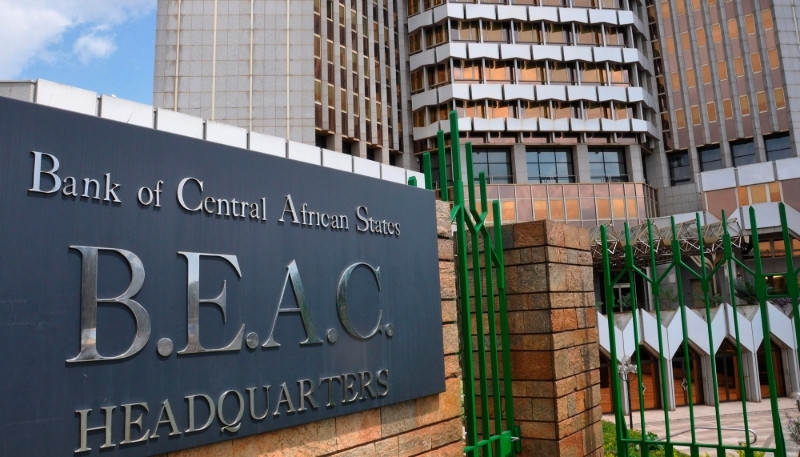Oil-linked liquidity shock contained by BEAC action
BEAC’s CFAF 750bn tender steadies CEMAC liquidity as growth trends 2.6% and inflation 2.6%. Watch BZ=F and EMB for oil and frontier spread signals while interbank spreads compress and BVMAC one-year yields retrace into Q1-2026.

The Bank of Central African States injected CFAF 750 billion on 15 October 2025 into the CEMAC money market, the second oversized tender in as many weeks after a CFAF 700 billion operation on 7 October. Credit demand outstripped the new offer at roughly CFAF 786 billion, confirming a persistent liquidity mismatch rather than a transient quarter-end effect.
The decision lands against a deteriorating hydrocarbon backdrop and a softer external position: regional growth is projected around 2.6% in 2025, inflation is expected to decelerate toward 2.6% from 4.1% in 2024, and foreign-exchange reserves are forecast near CFAF 7.10 trillion at year-end, covering 4.59 months of imports versus 4.82 months in 2024.
General government debt is clustered around the low-50s percent of GDP region-wide, while Gabon and the Republic of Congo sit higher—roughly 78–80% and 89–94%, respectively—tightening the sovereign–bank feedback loop that defines the region’s transmission mechanism.
The causality is direct. Oil and gas receipts feed fiscal deposits, which anchor system liquidity. As budgetary transfers slow with weaker export proceeds and repatriation slippage, banks’ core funding shrinks, wholesale rates rise, and recourse to central bank refinancing scales up. The system’s sovereign concentration—domestic public paper near a third of bank assets in several markets—magnifies the shock: rollover risk and mark-to-market stress transmit quickly to the interbank curve.
By expanding the main refinancing envelope to CFAF 750 billion and taking regional government securities as collateral, the central bank compresses interbank spreads, stabilizes the short end of the BVMAC curve, and reduces forced asset sales by liquidity-short institutions. The tender also smooths sovereign cash-flow peaks and lowers execution risk around 2026–2027 amortization bulges.
Macro transmission should appear in three channels over Q4 2025. First, interbank rates should re-align toward the policy corridor, easing marginal funding costs and anchoring one-year Treasury yields. Second, private-sector credit growth should avoid a pro-cyclical contraction even as governments continue to absorb a large share of balance sheets; crowding-out remains the principal constraint on SME lending. Third, reserves should remain contained if the operation addresses local-currency liquidity without igniting incremental FX demand; with coverage projected at 4.59 months, the union can absorb temporary injections but not sustained quasi-fiscal monetization.
The policy signal is defensive but credible. The authorities are prioritizing monetary-policy transmission and sovereign rollover stability while keeping the policy rate steady after the March easing. Liquidity is being used as the first-line instrument ahead of any change to the peg or policy rate structure.
The intervention indirectly supports domestic reprofiling's by preserving banks’ capacity to warehouse sovereign risk. Recent exchanges in Gabon—roughly CFAF 592 billion extended from about two to six years—illustrate the dependence of debt-management operations on bank balance-sheet elasticity; without central bank liquidity, execution risk would have ratcheted up and spilled into private credit pricing.
Market reaction should be moderately constructive. Short-end yields are likely to compress as the interbank curve softens, and spreads for higher-quality issuers should tighten as rollover risk recedes. The oil complex remains the swing variable for fiscal cash flow; Brent front-month futures (BZ=F) near $80 per barrel stabilize revenue trajectories, while a sustained slide toward $65 would widen funding gaps and pressure allotment sizes. Inflation’s glide toward the 3% convergence benchmark preserves policy space, but imported-food sensitivity keeps second-round risks live, especially in narrower-base economies.
The risk set is defined and measurable. Repeated tenders of this scale that push net domestic assets growth above 10% year-on-year would indicate creeping monetization if fiscal consolidation lags. A faster reserve drawdown would tighten the external constraint and reignite peg speculation. Sovereign interest-to-revenue ratios in the high-40s percent range in some members keep rollover risk elevated despite liquidity backstops.
The base case remains orderly, contingent on three markers by end-Q1 2026: the interbank–policy spread sustained within ±50 basis points; the BVMAC 12-month auction yield retracing 100–150 basis points from its September fixing; and reserve cover holding at or above 4.5 months. If these thresholds are met while BZ=F averages $75–85 and frontier hard-currency spreads, proxied by EMB, stabilize, the intervention will have bridged the liquidity gap without eroding the policy framework or the credibility of the peg.





